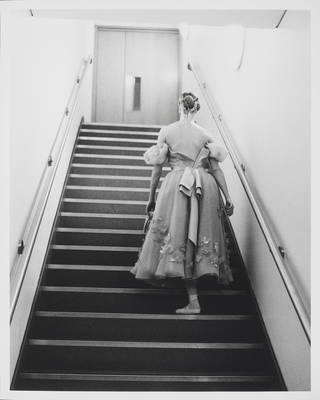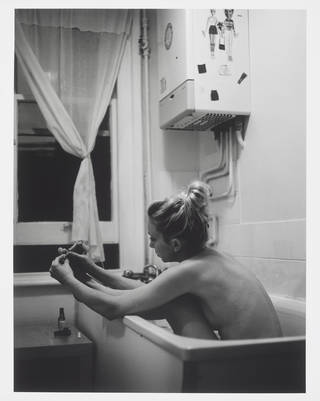Mary McCartney's seminal series, 'Off Pointe – A Photographic Study of the Royal Ballet After Hours', captures ballet dancers in unguarded, behind-the-scenes moments as they prepare for performances at The Royal Opera House.
After a long fascination with ballet, it was a night out in 2004 in London's Soho with Royal Ballet dancer, Sian Murphy, that inspired McCartney to reveal unseen aspects of the ballet world, including "the highs and lows and the prestige and chaos behind the scenes".

McCartney chose to shoot Off Pointe in black and white for its gritty, filmic quality. She wanted her images to look timeless, inviting viewers to fill in the gaps. After spending a significant period getting to know Murphy and her fellow dancers, McCartney was granted access to photograph intimate moments inside their homes and dressing rooms to capture everything but the stage. From dancers smoking in-between acts and drinking Diet Coke in their dressing rooms, to gnarled feet soaking in a bath and the haunting image of an exhausted lone dancer climbing the stairs, her bodice gaping open post-performance, McCartney's series depicts the real-life dedication behind the poised perfection seen on-stage.
I’m inspired to make photographs that have a candid, honest quality. Through Off Pointe, I wanted to document the hidden details of the ballet world and reveal the contrast between the sometimes gruelling, painful lifestyle of the dancers and their fairy-tale performances.
Mary McCartney took up photography in her youth and has since exhibited around the world. Her photography strives to capture moments in time and find the beauty in the everyday.
We asked Mary a series of questions about her photography to find out about her inspiration and the development of her art:

What's your earliest photographic memory?
"Around the age of 5 years old, my mother took me to her little darkroom, I remember the thrill of seeing her lower a white sheet of paper into what looked like water, and as she swished it gently around a black and white image magically appeared."
How did you first get into photography?
"I was always interested in photography. My mother took photographs in such a relaxed and low key manner it seemed natural. Then one evening, looking through the snapshots taken by one of my best friends, I realised that not everyone had that talent. I'd taken this for granted before then. That is when I decided."
What is your favourite camera to shoot on?
"A Leica R7 – a present from mum. When I told her I was going to take up photography she gave it to me. I have favoured Leica ever since. When I pick up a Leica it makes me feel just that little bit more inspired. I love the lenses and the classic, no fuss design. And the sound of the shutter release button when I press it down is like nothing else, so satisfying. It makes me feel at home."

Do you prefer to shoot in colour or black and white?
"I began working in black and white in the early 1990s, as the photographers that inspired me first shot in black and white, such as Linda McCartney, Diane Arbus, Garry Winogrand and Jacques Henri Lartigue. Now I shoot more colour than black and white, as I find it more challenging, which then makes me more intrigued. I am always looking to take stand alone images that will sustain the interest of myself and the viewer."
Do you feel you have a signature style?
"I am driven to find personal moments to capture in one image. Photographs that have a candid and honest quality to them. Photographs that will catch the imagination of my viewer."

Has social media changed your approach to photography?
"Yes, it allows for more freedom. Generally the photographs I upload onto social media are taken on my iPhone. I started a project called #someone that started spontaneously as a portrait project when I saw someone that caught my eye in the park. I use Instagram as the platform to share it."
Why did you set up #someone?
"In response to the democratisation of photography, made possible through the smartphone and rise of Instagram. It is about the triumph of reality and its unarguable, real life. It's inclusive and is an open invitation to anyone to get involved in the conversation. Real life and observing it."
Fourteen prints from the series Off Pointe have been gifted to the V&A's permanent collection of photographs.


